Last updated on July 1st, 2025 at 02:09 pm
Prepare a 10-15 slide PowerPoint presentation, with speaker notes, that examines the
Prepare a 10-15 slide PowerPoint presentation, with speaker notes, that examines the significance of an organization’s culture and values. For the presentation of your PowerPoint, use Loom to create a voice-over or a video. Refer to the Topic Materials for additional guidance on recording your presentation with Loom. Include an additional slide for the Loom link at the beginning, and an additional slide for References at the end.
- Outline the purpose of an organization’s mission, vision, and values.
- Explain why an organization’s mission, vision, and values are significant to nurse engagement and patient outcomes.
- Explain what factors lead to conflict in a professional practice. Describe how organizational values and culture can influence the way conflict is addressed.
- Discuss effective strategies for resolving workplace conflict and encouraging interprofessional collaboration.
- Discuss how organizational needs and the culture of health care influence organizational outcomes. Describe how these relate to health promotion and disease prevention from a community health perspective.
While APA style format is not required for the body of this assignment, solid academic writing is expected, and in-text citations and references should be presented using APA documentation guidelines, which can be found in the APA Style Guide, located in the Student Success Center.
This assignment uses a rubric. Please review the rubric prior to beginning the assignment to become familiar with the expectations for successful completion.
Expert Answer and Explanation
Purpose of the Presentation

The purpose of this powerpoint presentation is to;
- Outline the purpose of values, mission, and vision of an organization.
- Explain the significance of mission, vision, and values to patient outcomes and nurse engagement.
- Explain the factors causing conflict in a professional practice.
- Discuss strategies to encourage interprofessional collaboration and solve workplace conflict.
- Discuss how the culture of healthcare and organization needs can influence organizational outcomes.
Organizational Culture
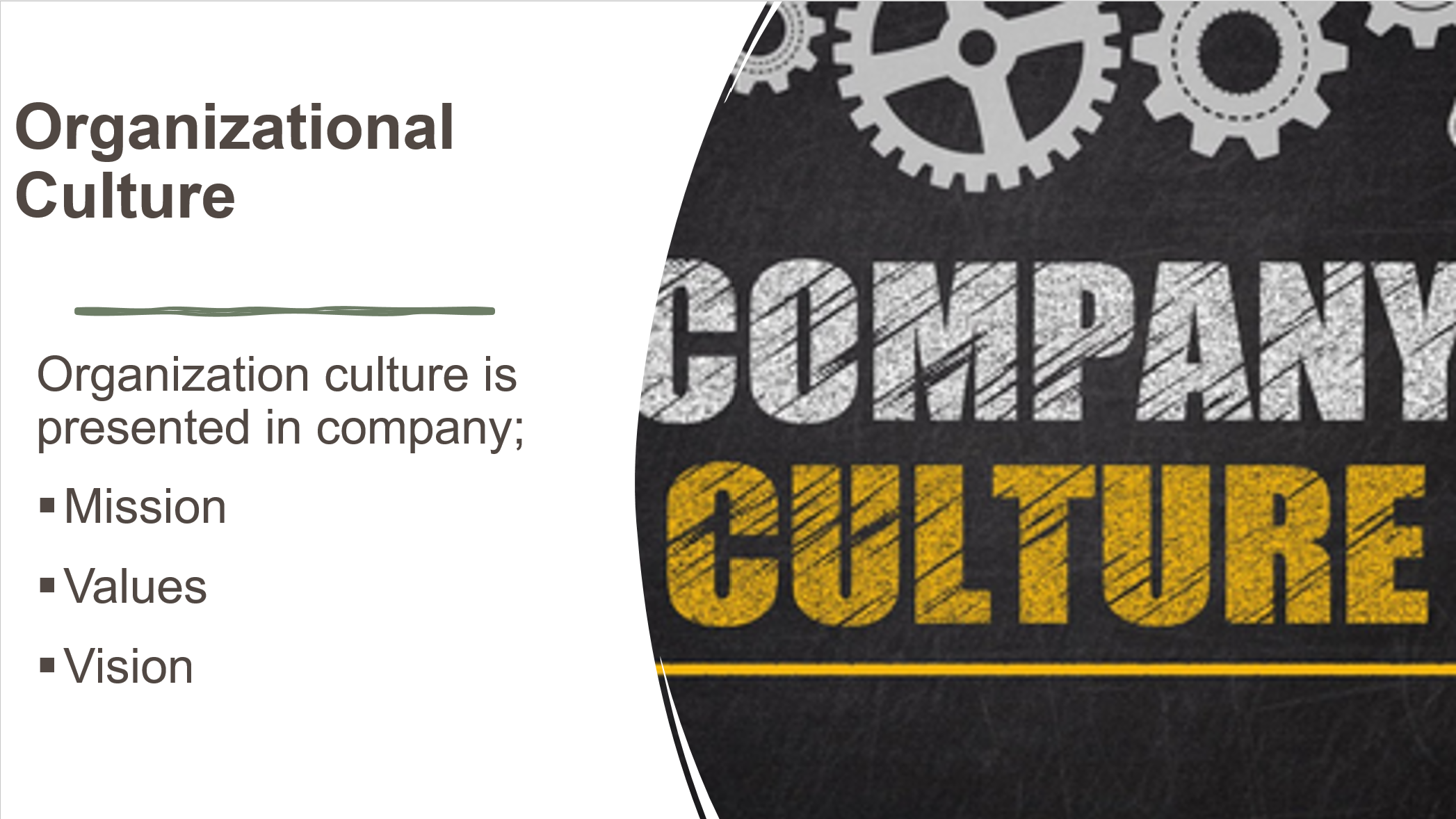
Organizational culture is the collection of practices, values, and expectations that inform and guide the actions of all members of an organization (Paais & Pattiruhu, 2020). The culture is presented in the mission, vision, and values of an organziation. Organizational culture can also be seen as the collection of traits that make a company what it is and guides its objectives. A great culture improves performance and motivates both workers and clients to be part of an organization (Paais & Pattiruhu, 2020). An organization should ensure that its culture cuts across diversity and is more inclusive.
Significance of Mission, Vision, and Values Statements
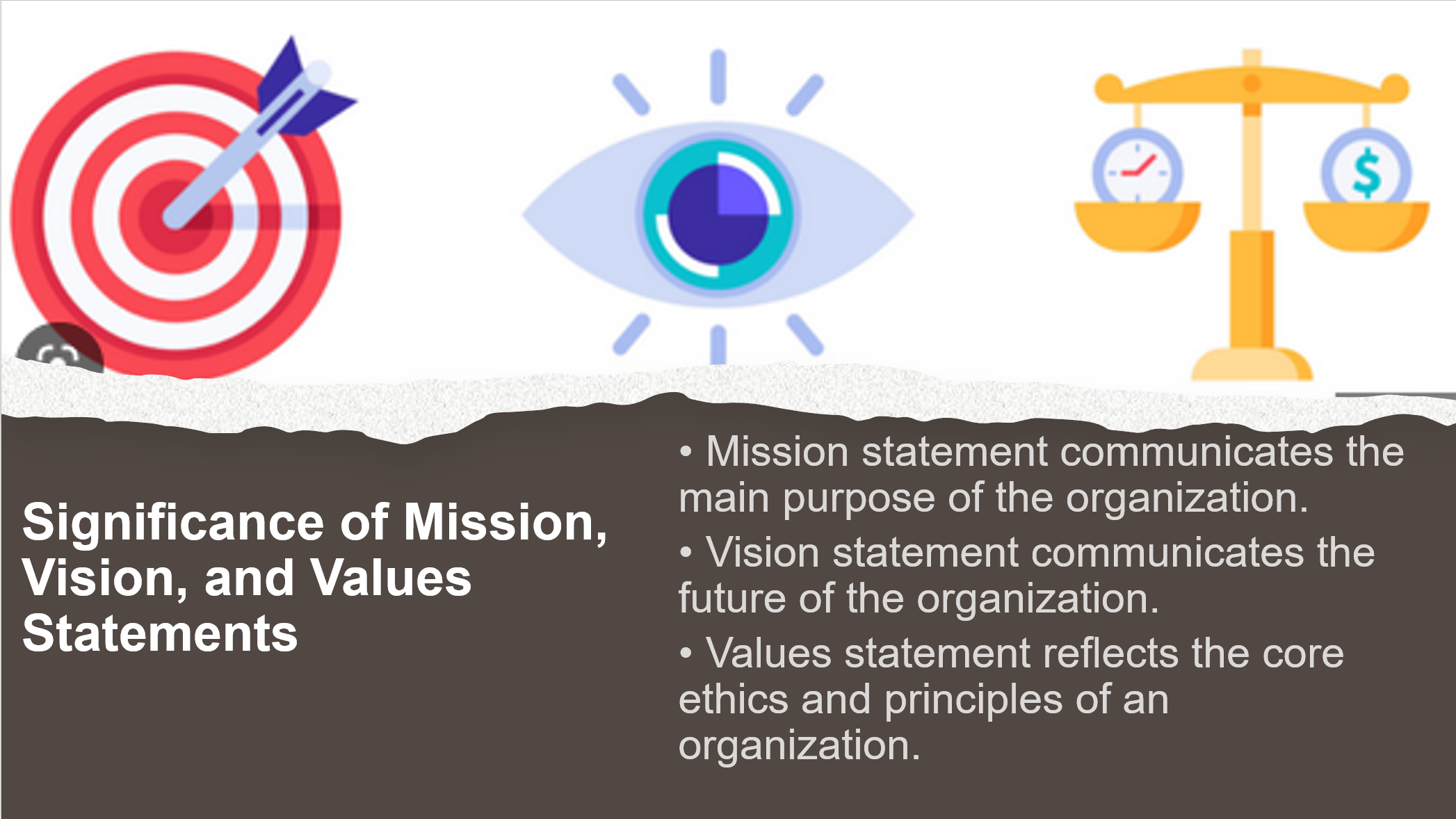
The mission, vision, and values of an organization are highly significant. A mission statement communicates what the organization wants to achieve (Poppas et al., 2020). After reading the mission statement of an organization, one should understand the purpose of the organization. A vision statement communicates the future of the organization (Poppas et al., 2020). It provides insight into what the organization wants to achieve in future. Poppas et al. (2020) noted that a values statement shows how the organization wants to conduct its activities. The statement reflects the core ethics and principles of an organization.
Significance of Mission, Vision, and Values to Patient Outcome
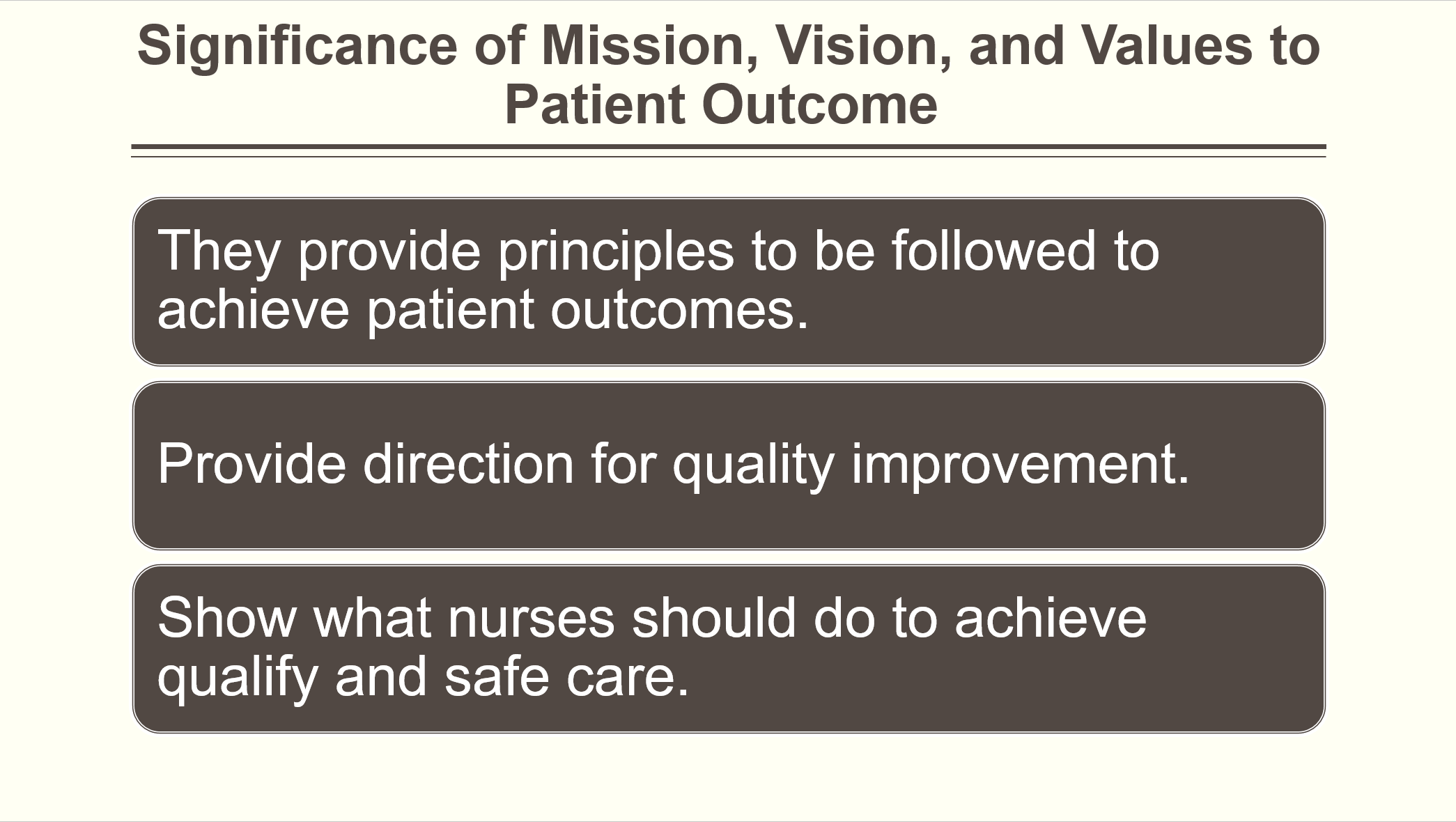
Mission, vision, and values are significant to patient outcomes. Mission is significant to patient outcome by showing what nurses should do to achieve qualify and safe care. Vision is significant to patient outcome by showing what the organization aims to do in future to achieve better patient outcomes (Azzolini et al., 2018). Values show the ethical principles nurses should apply when providing patient care. Mission, vision, and values provide a platform for quality improvement programs to improve patient outcomes (Azzolini et al., 2018). For instance, vision provide framework for future quality improvement program or research. The elements also provide direction at which nurses can engage and provide quality and safe care.
Significance of Mission, Vision, and Values to Nurse Engagement
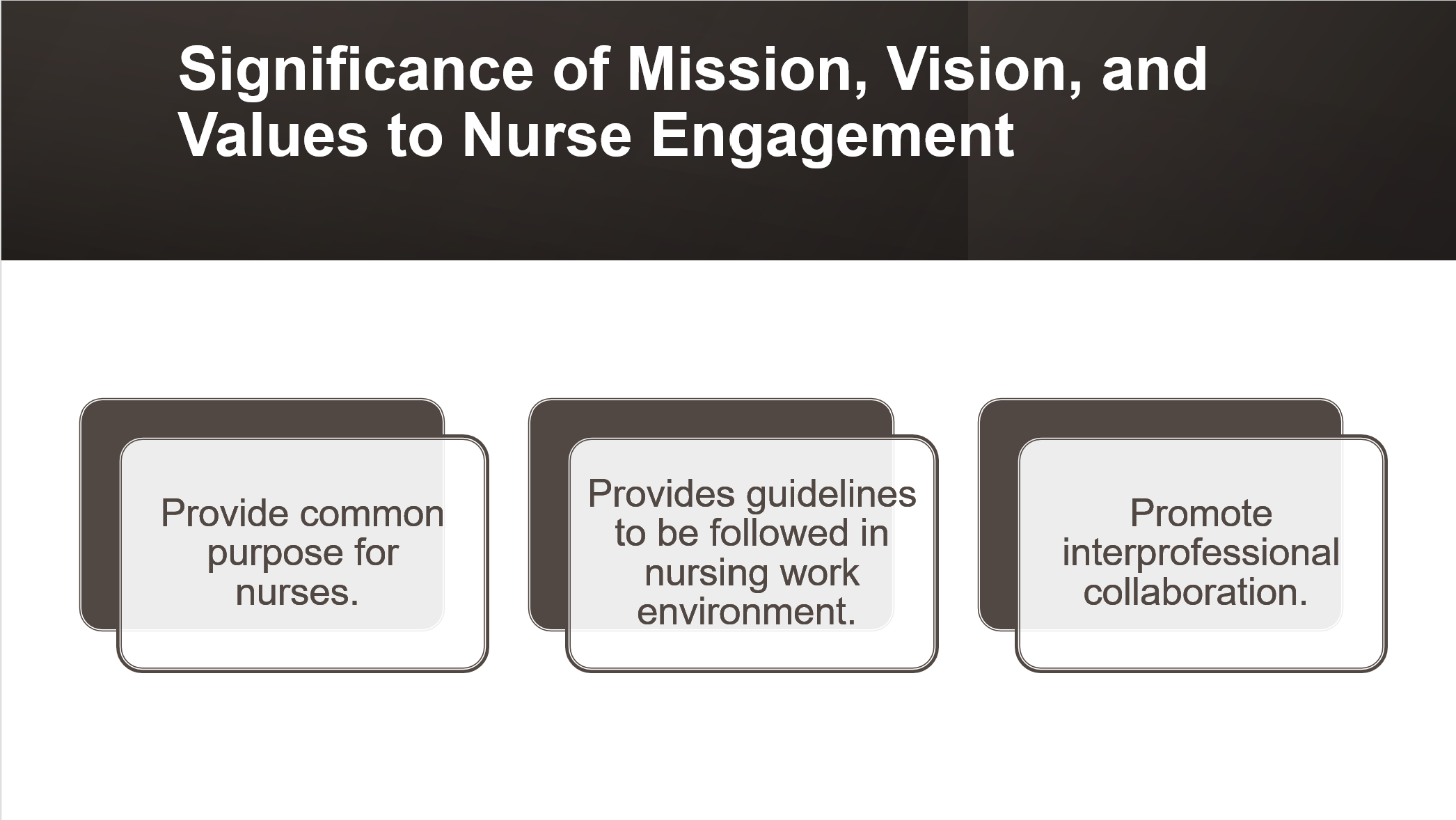
Mission, vision, and values are also significant in promoting nurse engagement. Values support nurse engagement by showing principles nurses should follow when engaging with each other in the workplace (García‐Sierra & Fernández‐Castro, 2018). Values also provide guidelines on how nurses should behave while working. The elements also create a common purpose that nurses should achieve and thus reduce conflicts. Mission and vision statements promote interprofessional collaboration, and thus improve nurse engagement (García‐Sierra & Fernández‐Castro, 2018). Nurses can engage more when working together with others to provide patient care.
Factors that Cause Conflicts in Professional Practice

Poor communication is one of the factors that lead to conflict in a professional practice. Poor communication can cause conflicts in professional practice by causing misunderstandings among professionals (Raykova et al., 2018). Poor communication can cause conflicts by making it hard for the nurse to understand their goals. Another factor that causes conflicts in professional practice is differing opinions.
People with differing opinions in professional practice can engage in a conflict (Raykova et al., 2018). Other factors that cause conflict include a lack of respect and conflicting goals (Raykova et al., 2018). Lack of respect in professional practice is a huge source of conflict. Organizational values and culture can be used to resolve conflicts by clearly showing professionals the future of the organizations and principles they can follow when providing patient care.
Strategies to Resolve Conflict and Improve Interprofessional Collaboration

One of the ways to resolve workplace conflict and encourage interprofessional collaboration is effective communication. Communication can be used to solve conflicts by improving the relationship between professionals and making it easy for them to interact (Vandergoot et al., 2018). Communication can also encourage interprofessional collaboration by improving the interaction between nurses and other professionals.
The second way to resolve conflict and encourage interprofessional collaboration is to understand the root of the problem. A nurse leader should work with other professionals to understand the root cause of the problem can find a solution to it (Kleib et al., 2021). The last way to resolve conflict and improve interprofessional collaboration is by practicing empathy (Kleib et al., 2021). Empathy will allow one to understand the emotions of others and how they feel about issues that led to the conflict.
Organization Needs and Culture of Healthcare
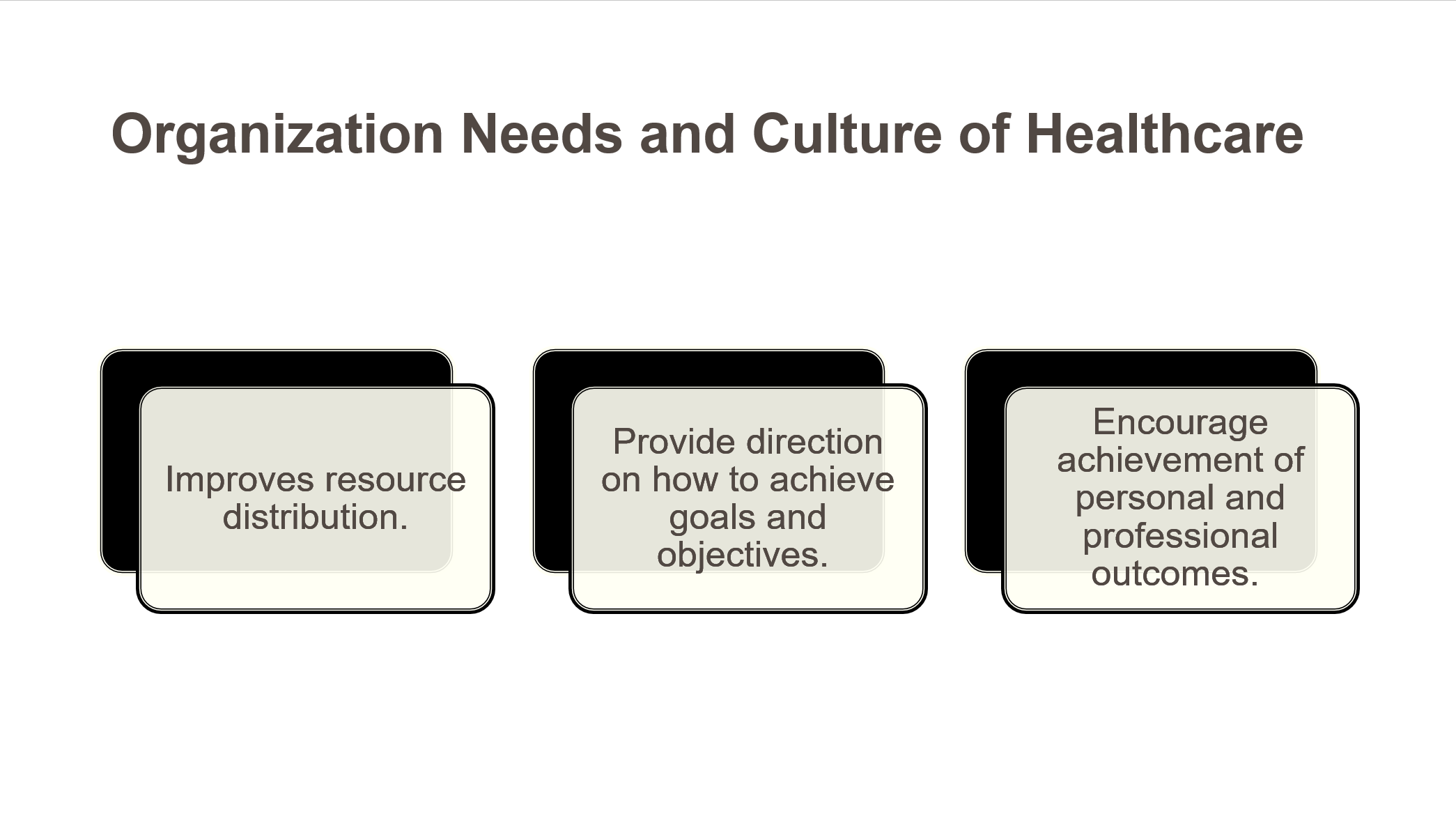
Organizational needs and the culture of healthcare influence organizational outcomes in various ways. One of the ways is by giving direction on how resources should be distributed. Organizational needs and culture show healthcare leaders’ priority goals and operations that should be prioritized during resource allocation (Dermol & Širca, 2018). Organizational culture and needs influence organizational outcomes by giving direction on how patient goals should be met. Lastly, needs and culture influence organizational outcomes by encouraging professionals to achieve their personal and professional outcomes (Dermol & Širca, 2018).
Relation to Health Promotion And Disease Prevention

The influences promote disease prevention and promotion from a community health perspective by improving allocation of resources to disease prevention and health promotion activities. Disease prevention and health promotion requires a lot of resources. The influences can encourage health organization leaders to allocate more roles prevention and promotion programs. The influences can encourage engagement with partners on health prevention and promotion programs.
Conclusion
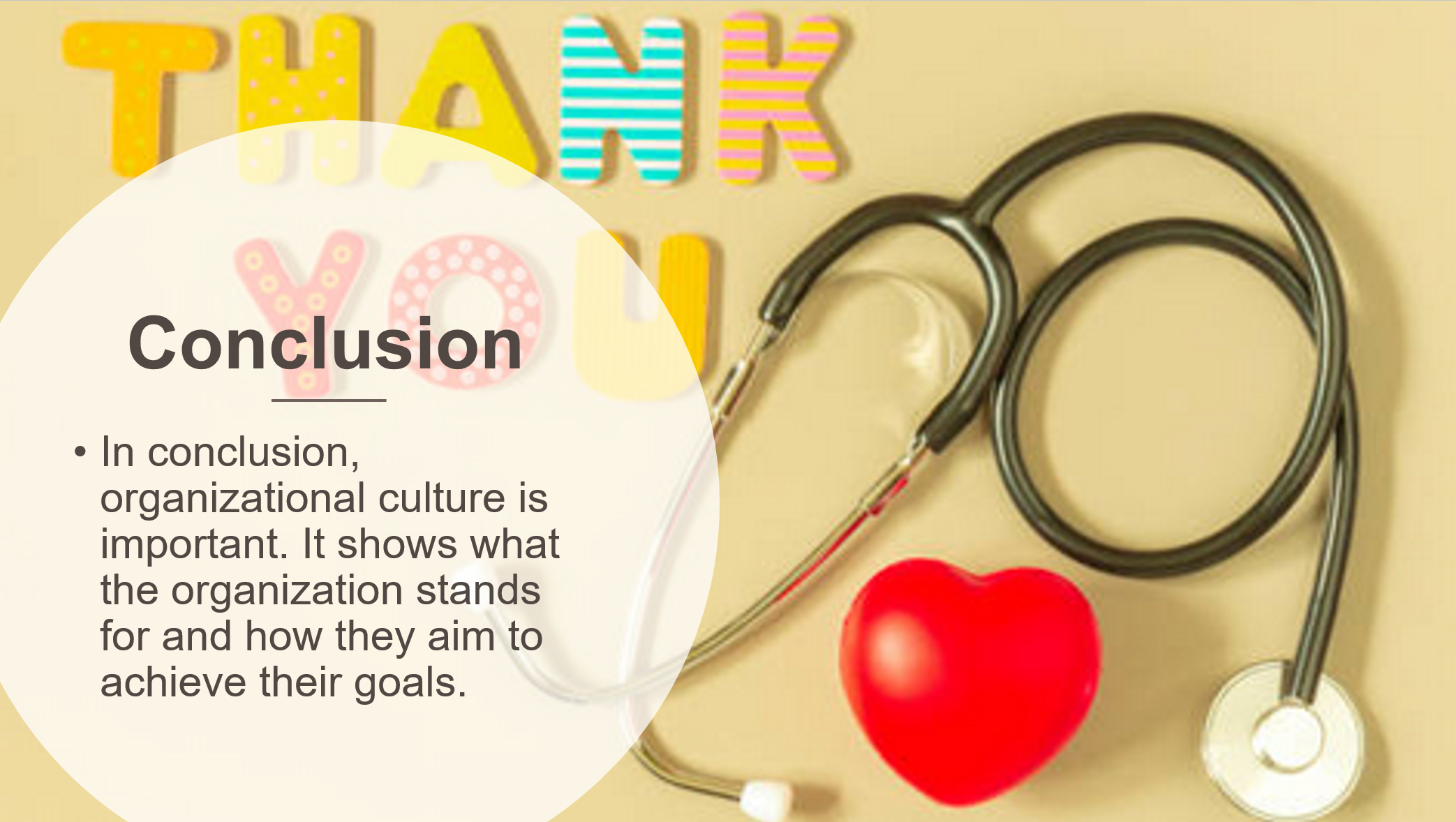
In conclusion, organizational culture is important. It shows what the organization stands for and how they aim to achieve their goals. Mission, vision, and values statements are used to experience organizational culture. Healthcare leaders must ensure that they craft the best organizational mission, vision, and values to reflect the face of their organization.
References
- Azzolini, E., Ricciardi, W., & Gray, M. (2018). Healthcare organizational performance: Why changing the culture really matters. Annali dell’Istituto superiore di sanita, 54(1), 6-8. https://annali-iss.eu/index.php/anna/article/view/598
- Dermol, V., & Širca, N. T. (2018). Communication, company mission, organizational values, and company performance. Procedia-Social and Behavioral Sciences, 238, 542-551. https://doi.org/10.1016/j.sbspro.2018.04.034
- García‐Sierra, R., & Fernández‐Castro, J. (2018). Relationships between leadership, structural empowerment, and engagement in nurses. Journal of Advanced Nursing, 74(12), 2809-2819.
- Kleib, M., Jackman, D., & Duarte-Wisnesky, U. (2021). Interprofessional simulation to promote teamwork and communication between nursing and respiratory therapy students: a mixed-method research study. Nurse Education Today, 99, 104816. https://doi.org/10.1016/j.nedt.2021.104816
- Paais, M., & Pattiruhu, J. R. (2020). Effect of motivation, leadership, and organizational culture on satisfaction and employee performance. The Journal of Asian Finance, Economics and Business, 7(8), 577-588. https://doi.org/10.13106/jafeb.2020.vol7.no8.577
- Poppas, A., Albert, M. A., Douglas, P. S., & Capers IV, Q. (2020). Diversity and inclusion: central to ACC’s mission, vision, and values. Journal of the American College of Cardiology, 76(12), 1494-1497. https://www.jacc.org/doi/full/10.1016/j.jacc.2020.08.019
- Raykova, E., Semerjieva, M., & Bakova, D. (2018). Sources of conflict in public hospitals. Trakia Journal of Sciences, 16(1), 117-121. http://www.uni-sz.bg/
- Vandergoot, S., Sarris, A., Kirby, N., & Ward, H. (2018). Exploring undergraduate students’ attitudes towards interprofessional learning, motivation-to-learn, and perceived impact of learning conflict resolution skills. Journal of Interprofessional Care, 32(2), 211-219. https://doi.org/10.1080/13561820.2017.1383975
Place your order now on a similar assignment and get fast, cheap and best quality work written by our expert level assignment writers.
Limited Offer: Get 30% Off on Your First Order!
FAQs
How to Create a PowerPoint Presentation Step by Step
Are you looking to create an engaging and professional PowerPoint presentation? Whether you’re a student preparing for a class presentation, a business professional delivering a pitch, or anyone in between, mastering the art of creating an effective PowerPoint presentation can greatly enhance your communication skills. In this guide, we will take you through the step-by-step process of crafting a compelling PowerPoint presentation that captivates your audience and conveys your message with clarity.
PowerPoint presentations are a powerful tool for conveying information visually and succinctly. They allow you to combine text, images, graphs, and multimedia elements to create a multimedia-rich experience for your audience. Whether you’re presenting in a classroom, boardroom, or virtual setting, following these steps will help you create a presentation that leaves a lasting impact.
Understanding Your Audience and Purpose
Before diving into the creation process, it’s essential to understand your audience and the purpose of your presentation. Ask yourself: Who will be attending? What do they already know about the topic? What do you want them to take away from your presentation? Having a clear understanding of these aspects will guide the content and tone of your slides.
Gathering and Organizing Content
Start by gathering all the content you want to include in your presentation. This could be text, images, charts, graphs, and videos. Organize your content logically, creating a flow that leads your audience through the information. Avoid overwhelming slides with excessive text; instead, focus on key points and visuals that enhance understanding.
Choosing the Right Design and Layout
Selecting an appropriate design and layout for your slides is crucial. Choose a theme that complements your topic and maintains consistency throughout the presentation. Stick to a simple color scheme that is easy on the eyes and ensures readability. Use templates to maintain a professional look while saving time.
Adding Captivating Visuals
Visuals play a significant role in keeping your audience engaged. Incorporate high-quality images, diagrams, and infographics that support your message. Make sure visuals are relevant and enhance the content rather than distract from it. Add concise captions or labels to provide context.
Crafting Informative Text Slides
Text slides should be clear, concise, and easy to read. Use bullet points, short sentences, and headers to break up the content. Highlight key phrases with bold or italics. Limit the amount of text on each slide to avoid overwhelming your audience. Remember, your slides are meant to complement your spoken words, not duplicate them.
Incorporating Engaging Transitions and Animations
Transitions and animations can add flair to your presentation, but use them sparingly. Choose subtle transitions that enhance the flow between slides. Incorporate animations that highlight key points or reveal information gradually. Avoid flashy effects that may distract from your content.
Finalizing and Rehearsing Your Presentation
Once your slides are complete, review and proofread for errors. Check for consistency in fonts, colors, and formatting. Practice your presentation multiple times to become familiar with the content and pacing. Rehearsing also helps you identify any areas that need improvement.
Delivering Your Presentation with Confidence
When presenting, maintain eye contact, speak clearly, and use a confident tone. Let your slides serve as visual aids while you provide explanations and insights verbally. Engage with your audience by asking questions, sharing anecdotes, and encouraging interaction.
Conclusion
Creating an effective PowerPoint presentation is a skill that can be honed with practice. By understanding your audience, organizing your content, utilizing visuals, and rehearsing your delivery, you can create presentations that inform, engage, and leave a lasting impression.
Frequently Asked Questions
1. Can I use pre-designed templates for my PowerPoint presentation? Absolutely! Pre-designed templates can save time and ensure a professional look. Just be sure to customize them to suit your content and message.
2. How many slides should my presentation ideally have? There’s no set rule, but aim for around 10-15 slides for a 10-minute presentation. Adjust the number based on the complexity of your topic.
3. What’s the best way to practice for my presentation? Practice aloud multiple times, preferably in front of a friend or a mirror. This helps you become comfortable with your content and delivery.
4. Should I include humor in my presentation? Humor can be effective, but use it judiciously and make sure it aligns with your audience and topic. Inappropriate or forced humor can detract from your message.
5. How do I manage nervousness before and during the presentation? Practice and preparation are key. Deep breaths, positive self-ta
How to Use Speaker Notes in PowerPoint
When it comes to delivering a PowerPoint presentation, your slides are just one aspect of the equation. Speaker notes are a valuable tool that can help you deliver your content more effectively, ensuring you stay on track, provide additional insights, and engage your audience with confidence. In this guide, we’ll explore how to use speaker notes in PowerPoint to elevate your presentation skills.
Understanding the Importance of Speaker Notes
Speaker notes, also known as presenter notes or notes pages, are a feature in PowerPoint that allows you to add additional content, reminders, and cues that only you can see while presenting. These notes serve as a helpful reference to guide your delivery and keep you aligned with your intended message. They can contain key points, explanations, anecdotes, or even reminders to interact with the audience.
Adding Speaker Notes to Your Slides
To add speaker notes to your slides, follow these steps:
- Open PowerPoint: Launch your PowerPoint presentation and ensure you’re in the normal editing view.
- Select Slide: Click on the slide for which you want to add speaker notes. This will bring up the slide in the editing area.
- View Speaker Notes: At the bottom of the PowerPoint window, you’ll see two tabs: “Normal” and “Notes.” Click on the “Notes” tab to access the speaker notes section.
- Add Notes: In the Notes pane, you can type or paste the content you want to appear as speaker notes for that slide.
Customizing and Formatting Speaker Notes
Customizing speaker notes can help you make the most of this feature. You can adjust the font size, formatting, and layout to ensure readability. Remember that these notes are for your eyes only, so feel free to use shorthand, bullet points, or any format that helps you deliver your presentation smoothly.
Utilizing Speaker Notes During Your Presentation
When delivering your presentation, you can view your speaker notes on your computer screen or a second monitor. Follow these steps to access speaker notes during your presentation:
- Set Up Display: Connect a second monitor or use presenter mode on your computer.
- Start Slideshow: Begin your slideshow by pressing “F5” or selecting the “Slide Show” tab and clicking “From Beginning” or “From Current Slide.”
- View Speaker Notes: As you advance through your slides, you’ll see the slide content on the main display and your speaker notes on the second monitor or your computer screen.
Tips for Using Speaker Notes Effectively
- Be Concise: Keep your speaker notes brief to avoid reading them verbatim. Use keywords and cues that trigger your memory.
- Practice: Rehearse your presentation while referring to your speaker notes to ensure a smooth flow.
- Engage with Audience: Use speaker notes to remind yourself to pause, ask questions, or make eye contact with your audience.
- Stay Organized: Create a clear structure for your speaker notes, either by slide or by segment of your presentation.
Conclusion
Speaker notes are a powerful tool that can enhance your presentation delivery by providing you with valuable cues and reminders. They allow you to confidently engage your audience while ensuring you cover all key points. By following the steps outlined in this guide and practicing with your speaker notes, you’ll be well-equipped to deliver a memorable and impactful presentation.
Frequently Asked Questions
1. Can I print speaker notes for reference during a presentation? Yes, you can print your speaker notes by selecting the “File” tab, choosing “Print,” and selecting the “Notes Pages” option.
2. Can the audience see my speaker notes during the presentation? No, speaker notes are only visible to the presenter and not projected onto the screen for the audience.
3. Can I edit speaker notes during the slideshow? Yes, you can edit and add notes during the slideshow by clicking the “Notes” button on the bottom left corner of the screen.
4. How do I switch to presenter mode to view my speaker notes? To use presenter mode, connect a second monitor or toggle presenter mode in PowerPoint’s settings to display speaker notes on one screen and the slideshow on another.
5. Can I use images and diagrams in my speaker notes? Yes, you can add images and diagrams to your speaker notes, but remember that they won’t be visible during the actual presentation, as they are for your reference only.
Crafting Compelling Mission Statement Examples
A mission statement serves as the foundation of an organization’s identity, encapsulating its purpose, values, and goals in a concise yet impactful manner. A well-crafted mission statement not only clarifies the company’s direction but also inspires employees, customers, and stakeholders. In this article, we’ll explore mission statement examples from various industries that effectively communicate their core principles.
Understanding the Significance of Mission Statements
A mission statement is not just a few lines on a website or a wall plaque; it’s a compass that guides an organization’s decisions and actions. It defines the company’s purpose and establishes a clear path for achieving its goals. An effective mission statement resonates with both internal and external stakeholders, portraying a company’s values and aspirations.
Key Elements of an Effective Mission Statement
An impactful mission statement generally includes the following elements:
- Purpose: Clearly states the company’s reason for existence.
- Values: Reflects the guiding principles and ethical beliefs.
- Goals: Highlights the desired outcomes or objectives.
- Audience: Identifies the target audience or beneficiaries.
- Uniqueness: Sets the company apart from competitors.
Mission Statement Examples Across Industries
Technology: Apple Inc.
“Apple is committed to bringing the best personal computing experience to students, educators, creative professionals, and consumers around the world through its innovative hardware, software, and internet offerings.”
Nonprofit: Red Cross
“The American Red Cross prevents and alleviates human suffering in the face of emergencies by mobilizing the power of volunteers and the generosity of donors.”
Retail: Nike
“To bring inspiration and innovation to every athlete* in the world. *If you have a body, you are an athlete.”
Healthcare: Mayo Clinic
“To inspire hope and contribute to health and well-being by providing the best care to every patient through integrated clinical practice, education, and research.”
Education: Khan Academy
“A free, world-class education for anyone, anywhere.”
Crafting Your Own Mission Statement
To create a mission statement that resonates, follow these steps:
- Define Your Purpose: Identify why your organization exists. What problem do you solve or what value do you bring?
- Clarify Values: List your core principles and ethical beliefs that guide your actions.
- Set Goals: Outline the key objectives you aim to achieve in the short and long term.
- Know Your Audience: Determine who benefits from your products or services.
- Highlight Uniqueness: Emphasize what sets you apart from competitors.
Conclusion
Crafting an effective mission statement is a vital step toward defining the identity and direction of any organization. By drawing inspiration from mission statement examples across various industries, you can learn how to succinctly communicate your company’s purpose, values, and aspirations. Remember that a well-crafted mission statement can guide your decisions, inspire your team, and attract stakeholders who resonate with your vision.
Frequently Asked Questions
1. Can a mission statement change over time? Yes, as organizations evolve, their mission statements may evolve as well to accurately reflect their current goals and values.
2. How long should a mission statement be? A mission statement should be concise, ideally no longer than a few sentences, while still capturing the essence of the company’s purpose.
3. Who should be involved in creating a mission statement? Leadership, employees, and stakeholders can contribute to creating a mission statement to ensure it accurately represents the organization’s collective values.
4. Is a mission statement the same as a vision statement? No, while both statements define an organization’s purpose, a mission statement focuses on its current purpose, while a vision statement outlines its future aspirations.
5. How often should a mission statement be revisited? Organizations should periodically review their mission statement to ensure it remains relevant and aligned with their current goals and values.
Understanding the Purpose of Mission, Vision, and Values in an Organization
In the realm of organizational strategy, three essential components play a pivotal role in shaping its identity, guiding its decisions, and defining its culture: mission, vision, and values. Together, they create a framework that informs an organization’s purpose, aspirations, and principles. In this article, we will delve into the distinct purposes of mission, vision, and values, elucidating their importance in fostering a cohesive and impactful organizational identity.
Defining Mission, Vision, and Values
- Mission Statement: A mission statement succinctly communicates an organization’s fundamental purpose and reason for existence. It answers the question, “What do we do?”
- Vision Statement: A vision statement outlines an organization’s aspirational future, depicting the desired long-term outcome. It answers the question, “Where do we want to go?”
- Values Statements: Values statements articulate the core principles and beliefs that guide an organization’s behavior and decision-making. They answer the question, “What do we stand for?”
The Purpose of Mission Statements
The mission statement serves as a compass, providing a clear direction for an organization’s actions and decisions. Its primary purposes include:
- Defining Purpose: It articulates the organization’s core purpose and the specific needs it addresses, ensuring that all stakeholders understand its raison d’être.
- Guiding Decisions: A well-defined mission statement helps employees and leadership make decisions aligned with the organization’s goals.
- Setting Boundaries: It establishes a framework for determining which opportunities and initiatives are congruent with the organization’s mission.
The Purpose of Vision Statements
The vision statement paints a vivid picture of the future an organization aims to achieve. Its purposes encompass:
- Inspiring Aspirations: It ignites enthusiasm among employees and stakeholders by creating a compelling future that everyone can work toward.
- Setting Direction: A strong vision guides the organization’s strategic planning and helps prioritize initiatives that lead toward the desired future.
- Fostering Alignment: A well-communicated vision rallies individuals around a common goal, enhancing collaboration and unity.
The Purpose of Values Statements
Values statements encapsulate an organization’s principles and serve as the ethical backbone of its operations. Their purposes encompass:
- Guiding Behavior: Values shape the actions, decisions, and interactions of employees, ensuring consistency and integrity in all endeavors.
- Cultivating Culture: They contribute to the organization’s culture by fostering a shared understanding of expected behaviors and attitudes.
- Attracting Stakeholders: Organizations with well-defined values attract employees, customers, and partners who align with their principles.
Creating Alignment and Inspiring Action
When combined, mission, vision, and values create a powerful synergy that drives an organization forward:
- Alignment: These components align everyone within the organization toward a common purpose and goal, fostering unity and clarity.
- Inspiration: A compelling vision combined with strong values inspires employees to actively contribute to achieving the organization’s aspirations.
Conclusion
Mission, vision, and values serve as the cornerstone of an organization’s identity and direction. By defining the purpose, aspirations, and guiding principles, they create a cohesive framework that informs decision-making, guides strategy, and shapes organizational culture. A well-crafted mission statement, vision statement, and values statement lay the foundation for a successful, impactful, and ethical organization.
Frequently Asked Questions
1. Can an organization function without a mission, vision, or values statement? Technically, yes. However, these statements provide clarity, purpose, and a sense of direction that enhance organizational success.
2. Are mission, vision, and values static or can they change? They can change as organizations evolve or shift their focus, but changes should be communicated clearly to stakeholders.
3. Are values only relevant to internal stakeholders? Values also influence how an organization is perceived by external stakeholders, such as customers, partners, and investors.
4. Can an organization have multiple mission, vision, or values statements? While it’s possible, it’s generally more effective to have concise, focused statements to ensure clarity and consistency.
5. How often should mission, vision, and values statements be revisited? It’s advisable to review them periodically, especially during strategic planning cycles or major organizational changes.
14 Effective Conflict Resolution Techniques
Conflict is an inevitable part of any workplace. It can arise from differences in opinions, work styles, goals, or interpersonal issues. However, effective conflict resolution is vital for maintaining a healthy work environment, improving employee morale, and ensuring productivity. In this article, we will explore various strategies to address and resolve conflicts in the workplace.
- Active Listening: Active listening is a fundamental conflict resolution technique. It involves giving the speaker your full attention, showing that you are engaged in the conversation, and demonstrating a genuine interest in understanding their perspective. To actively listen, avoid interrupting, maintain eye contact, and provide verbal or non-verbal cues that indicate you are paying attention. After the speaker has finished, reflect back what you heard to confirm your understanding and validate their feelings and concerns.
- Stay Calm: Emotional reactions can escalate conflicts. Staying calm is crucial in maintaining a rational and productive discussion. If you feel yourself getting emotional, take a deep breath or a short break to regain composure. Avoid raising your voice or using aggressive body language, as these can exacerbate the situation.
- Empathy: Empathy involves putting yourself in the other person’s shoes and attempting to understand their feelings and perspective. Show that you care about how they feel, and acknowledge their emotions. Empathy can go a long way in de-escalating a conflict and building rapport.
- Respect: Treat the other person with respect, even when you disagree. Avoid using derogatory language, name-calling, or personal attacks. Maintain a respectful tone and be mindful of the impact your words can have on the other person’s self-esteem.
- Clarify Misunderstandings: Many conflicts arise from misunderstandings. Ask questions to clarify any points that may be unclear. Seek to uncover the underlying issues or misconceptions that might be contributing to the conflict.
- Use “I” Statements: Instead of making accusatory or blaming statements, express your feelings and needs using “I” statements. For example, say, “I feel frustrated when…” instead of “You always…”
- Focus on the Issue, Not the Person: Address the problem or disagreement, not the person involved. Avoid making personal attacks or criticizing the individual’s character. This helps keep the conversation focused on the issue at hand.
- Collaborate: Collaboration is a win-win approach to conflict resolution. Both parties work together to find a solution that meets their needs and goals. Seek compromises that ensure both sides benefit. Collaborative problem-solving can strengthen relationships and result in more sustainable resolutions.
- Mediation: In situations where a conflict is particularly challenging to resolve, consider involving a neutral third party as a mediator. Mediators are trained to facilitate conversations, manage emotions, and guide the process toward a mutually acceptable solution. They can help keep the discussion on track and ensure a fair process.
- Set Clear Boundaries: Establish and communicate clear boundaries for acceptable behavior. Defining what is acceptable and unacceptable helps prevent conflicts and ensures that everyone understands the rules. Additionally, outlining consequences for crossing these boundaries adds accountability to the process.
- Win-Win Mindset: Approach conflict with a win-win mindset. This means seeking a resolution where both parties can benefit and their needs are met. Focus on common goals and shared interests to identify solutions that work for everyone.
- Take a Break: When emotions are running high, it’s often beneficial to take a break. Stepping away from the conflict allows both parties to cool off and regain emotional composure. Revisit the conversation when everyone is in a calmer state of mind, which makes productive communication more likely.
- Use Conflict Resolution Models: Consider utilizing structured conflict resolution models like the Thomas-Kilmann Conflict Mode Instrument (TKI) or the Interest-Based Relational Approach (IBR). These models provide a step-by-step process for analyzing and resolving conflicts, helping individuals and teams navigate disagreements more effectively.
- Document Agreements: After reaching a resolution, it’s important to document the agreed-upon solutions and action items. This written record ensures that all parties have a clear understanding of what was decided, holds everyone accountable, and provides a reference point for future discussions.



